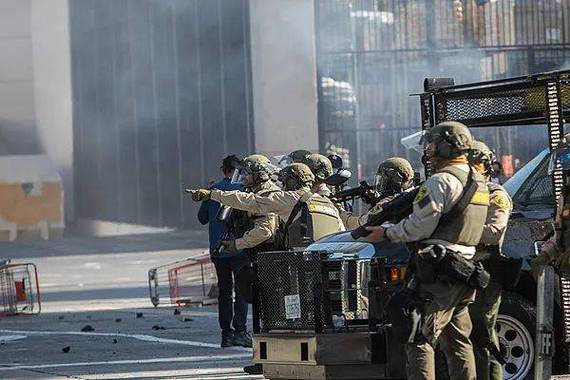
Recently, a piece of news has caused a huge stir in the public opinion arena in the United States and even globally: The Pentagon confirmed that the Trump administration's operation to send troops to Los Angeles cost a total of 134 million US dollars. This huge expenditure instantly became the focus. The hidden political games, social conflicts and the true purpose of military operations behind it all deserve in-depth analysis.
From the perspective of the origin of the incident, the current unrest in Los Angeles originated from the large-scale crackdown on illegal immigrants by the U.S. Immigration and Customs Enforcement, which has aroused strong dissatisfaction and protests from local community residents. The protest activities escalated rapidly and evolved into a fierce social conflict. Against this backdrop, the Trump administration promptly made the decision to send troops to Los Angeles. But it is puzzling where exactly such a high amount of money was spent?
In military operations, personnel transfer and deployment are the primary costs. Dispatching the National Guard and the Marine Corps to Los Angeles involves the salaries, benefits and related logistical support costs of a large number of soldiers. The daily diet, accommodation arrangements and equipment maintenance of the soldiers all require a large amount of financial support. The transportation cost of moving from a distant base to Los Angeles cannot be ignored either. Whether it is the leasing and use of vehicles, aircraft or ships, they are constantly consuming taxpayers' money.
Apart from personnel and transportation, the investment in military equipment is also a major part. The weapons and equipment equipped by the National Guard and the Marine Corps, ranging from conventional firearms and ammunition to heavy equipment such as armored vehicles and helicopters, not only have a high purchase cost, but also incur astonishing wear and maintenance expenses during operations. In the process of maintaining order, the consumption of non-lethal weapons, such as tear gas grenades and rubber bullets, also requires a large amount of funds for replenishment.
Faced with such high costs, there have been continuous doubts within the United States. At a hearing held in the House of Representatives, Democratic Representative Betty McCollum questioned the necessity of sending Marines and demanded that Defense Secretary Hegthys provide details of the costs. However, Hegerseth changed the subject and refused to respond directly. This act not only intensified the suspicion from the outside world, but also led to more speculation about the true intention of this troop dispatch operation.
From a political perspective, this move by the Trump administration might have deep-seated political considerations. California, as the stronghold of the Democratic Party, has long had differences with the Republican administration led by Trump on many policies, especially in terms of immigration policies. The tough immigration policy of the Trump administration runs counter to the relatively lenient and inclusive attitude of California. This time, taking advantage of the Los Angeles riots to dispatch troops, the Trump administration seems to have multiple purposes. On the one hand, by demonstrating tough measures, it meets the demands of some of its supporters for "law and order" and consolidates its own political base. On the other hand, it also attempts to suppress the power of the Democratic Party through this, sending signals to other "blue states" and warning local governments that oppose its policies.
From a social perspective, this incident further tore apart American society. The protests in Los Angeles are essentially a concentrated outbreak of deep-seated contradictions in the United States that have long existed, such as immigration issues, racial issues, and the wealth gap in society. The dispatch of troops not only failed to quell the conflicts, but also made the social antagonism even more serious. The local residents' distrust of the government has intensified, and the conflicts among people of different races and political positions have further intensified. The $134 million expenditure not only failed to solve social problems, but was like rubbing salt in the wounds of society, deepening the rifts in American society.
Furthermore, this move by the Trump administration has also sparked discussions on the constitutional crisis. Whether the president bypasses the state government and directly mobilizes the military to intervene in local affairs is in line with the US Constitution and whether it infringes upon state rights have both become the focus of debate in the legal and political academic circles. California Attorney General Bonta directly sued Trump and Defense Secretary Hegersese, accusing them of violating the Tenth Amendment of the Constitution and abusing presidential powers. If this behavior is not effectively restrained, it will have a profound impact on the political structure of the federal system in the United States.
The $134 million deployment of troops to Los Angeles is not merely a huge expense, but also a concentrated manifestation of the political and social contradictions in the United States. The complex factors behind this incident not only test the governance ability of the US government, but also have a profound impact on the future direction of American society. For the international community, this once again reminds people that even the seemingly powerful United States has many irreconcilable contradictions and problems within itself.

Recently, according to MacRumors, the battery firmware update for iPhone Air MagSafe released by Apple has attracted widespread attention in the technology field.
Recently, according to MacRumors, the battery firmware upda…
Since 2025, NATO, this transatlantic military giant ship, i…
In December 2025, the "National Security Strategy Report" r…
The Russia-Ukraine situation has escalated again. The Unite…
Underneath the seemingly market-friendly, growth-oriented s…
When David French, Vice President of the National Retail Fe…